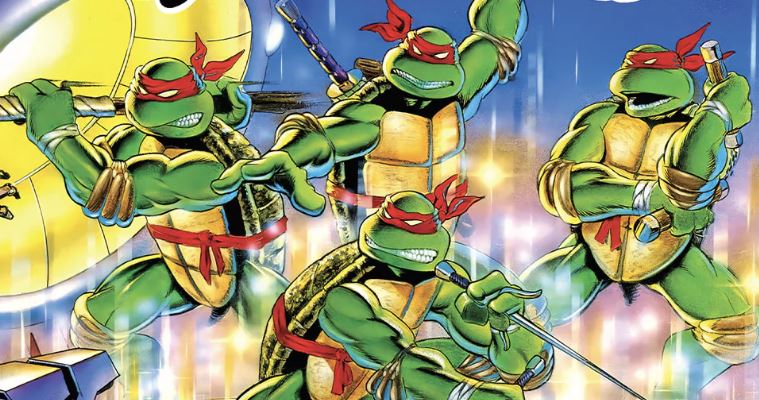The Bizarre Teenage Mutant Ninja Turtles Game You Probably Never Beat
It's not the first game you think about when you hear Teenage Mutant Ninja Turtles, b but the first TMNT game has a legacy of its own.

It’s the 35th anniversary of the first-ever video game based on the Teenage Mutant Ninja Turtles. While fans might have fond memories of the arcade title Teenage Mutant Ninja Turtles: Turtles in Time from 1991, or perhaps a sense of nostalgia for the 1990 Game Boy release Teenage Mutant Ninja Turtles: Fall of the Foot Clan, it was that NES that initially debuted the titular crime-fighters in the medium.
Teenage Mutant Ninja Turtles of 1989 fame is an infamous entry into the comic book characters’ video game library. Developed by Konami and released by Ultra Games in North America (and Palcom and U.S. Gold throughout European territories), the game was both utterly bizarre in its concepts and nearly impossibly difficult in its execution. This retro experience from a bygone era left many players frustrated.
Although its place in the Teenage Mutant Ninja Turtle timeline is undeniably important (the NES earned over $125 million worldwide), it already started to feel forgotten by the end of 1990. It certainly hasn’t aged well when compared to its TMNT contemporaries. But what made Teenage Mutant Ninja Turtles stand out from the pack, and why has it earned a reputation for being so unbeatable?
The NES Hit Invented Its Own Mythology
Look across the boss battles featured in Teenage Mutant Ninja Turtles on NES and you’ll notice familiar names like Rocksteady, Shredder, and…Big Mouser? The 1989 video game broke all the conventions and started adding characters that had never previously appeared in turtle lore.
Big Mouser and Mechaturtle are notable examples, with players getting baffled by these odd additions that lacked clear continuity. It was almost as if the developers hadn’t actually seen or read any Teenage Mutant Ninja Turtles tales. One theory suggests that the source material the developers were working with was so varied that it led to confusion when they came to putting together the narrative. What’s more, the influence of the 1987 title Getsu Fūma Den may have also been an underlying factor, with elements of that Konami game seemingly inspiring the first TMNT. The similarities between the two are numerous, leading to the conspiracy that TMNT acted as an overlay on or variation of that title.
Those strange inclusions didn’t end there. Of all the location choices available, players found themselves fighting through a level based on JFK Airport and across the rooftops of Wall Street. At the conclusion of the game, Splinter turns into his human form, shedding his rat appearance thanks to the player’s victory. Why? Well, most of the game’s plot revolves around the theft of the Life Transformer Gun, which is never really expanded upon, aside from its ability to apparently transform a rat into a man.
Each creative decision made throughout the title is full of strange nuances that don’t really reflect the Teenage Mutant Ninja Turtles canon. Many of these ideas and concepts that were introduced in the title were never seen again across the franchise, perhaps speaking to how they were received. Interestingly, the game was also the first major piece of TMNT media ever released in Japan. As a point of introduction, it’s an obscure one, going by a different name and including odd additions to the lore of its own (including a suggestion that April was Splinter’s daughter). Yet, the NES entry does have an important impact on the legacy of Turtlemania on a global stage, despite these strange alterations.
The Mechanics Made The Most Of Its Roster
Perhaps what was most intriguing about this NES game was that it emphasized the team dynamic of the turtles. Although this was a single-player game, Konami was clearly keen to allow and encourage players to control each of the individual turtles.
The player could switch between each of the four lead characters, and there would be benefits and setbacks for doing so. Just like in the comics and shows, each turtle boasts different talents and wields alternate weapons. The game informed players of those strengths and weaknesses, allowing them to make their decisions based on the challenges they faced. Each character was well suited to different scenarios and some of the difficulty of the title came from getting that selection process right and ensuring the right turtle was available at the right time.
But, if a turtle was defeated during combat, the player didn’t just switch to the next suitable alternative. Instead, the character was captured by the enemy, resulting in the player having to rescue their team member from the third level. It’s a fun idea in theory, but one that complicates the game further.
If all four turtles are defeated then it’s game over. However, players could get stuck in the loop of saving each character, as they face the most notorious levels of the game. Although characters could only be rescued once, your chances of progressing were limited if the team wasn’t intact. You really needed their varied skills. Teenage Mutant Ninja Turtles therefore emphasized an almost tactical edge. Konami would later develop that concept further in successor games, with their more acclaimed arcade-like Teenage Mutant Ninja Turtles outings perfecting that idea with their beat-em-up mechanics that better focused on how each character was portrayed.
That Dam Level
Most games possess an infamously challenging level that very few are able to overcome. Unfortunately for Teenage Mutant Ninja Turtles on the NES, it was the second level that posed such a threat.
Players were tasked with traveling through an underwater maze with a ticking timer in the background. The challenge was to disarm bombs before the turtle ran out of breath. The mission was intentionally tense, but inaccurate controls and a general clunkiness to the design of the level’s mechanics made the level a nearly impossible challenge for most. Even TMNT co-creator Kevin Eastman couldn’t beat that level, though he says that fans would sometimes blame him for it.
If players were, by some miracle, able to find a way to claim victory in that aquatic arena, they were then faced with an array of boss battles and territories to navigate that posed larger dangers. Levels five and six were notorious in their own right, and it was almost laughable to suggest that a player could complete the game without expert knowledge, hours of commitment, and nearly flawless execution.
There are plenty of theories as to why the developers made the game so famously difficult. It may well be because the game took more of its inspiration from the comics, which initially had an adult audience in mind. Aiming for an older target market, Teenage Mutant Ninja Turtles had to be challenging to keep that age group entertained. An alternative theory suggests that because the game only consists of six levels (and is therefore pretty short), audiences would feel like they got more value for their money if those levels offered a larger sense of victory after surpassing such unbelievable odds. It would also make the game feel so much larger than it actually was.
Irrespective of the reason, Teenage Mutant Ninja Turtles’ level design was laughably tough, with spikes shooting out of surfaces far too close to one another, enemies spawning in inconvenient places and levels benefitting from a specific turtle without any clues to say so. There is a good chance you never beat it when you were young, which means that the NES game is often best remembered for its often absurd difficulty alongside its reputation for bizarre storytelling. But it’s not all bad!
The Legacy Of Teenage Mutant Ninja Turtles
The Teenage Mutant Ninjas Turtles game on NES took risks that arguably paid off. People were talking about the game, and although the franchise element pushed sales, no press is bad press.
Critically the game received mixed reviews at the time, with its odd choices splitting players who loved the title’s unique qualities. Of course, the continued popularity of the turtles meant that other video games were always going to be produced in the line.
But some of those core mechanics and ideas paved the way for other releases. There were some genuine high points for TMNT on NES. Visually it was stunning, with the 8-bit adventure making the most of the console’s graphical potential. An energetic soundtrack compliments even the dullest moments, bringing enthusiasm to each sequence. What’s more, there are some genuinely great level designs mixed in with the infamous areas that tested players’ ability to maneuver through the combat controls and side-scrolling through the complex environments. Indeed, the very essence of Teenage Mutant Ninja Turtles on NES would go on to cultivate a line of beloved gaming experiences. Elements of that first iteration have filtered into its successors, so despite its flaws, it made a positive mark and cemented the turtles as power players in any medium.
The legacy of the NES game might be infamous, but there’s also a sense of nostalgia attached to it. It’s certainly one of a kind, but it showcases many of the things its successors would do, and, more importantly, not do with the property. Perhaps the 1989 release should be viewed not as part of the turtle line but instead as an entity unto itself. One that pushed players at every stage and is still talked about to this day as a creatively colorful experience.
